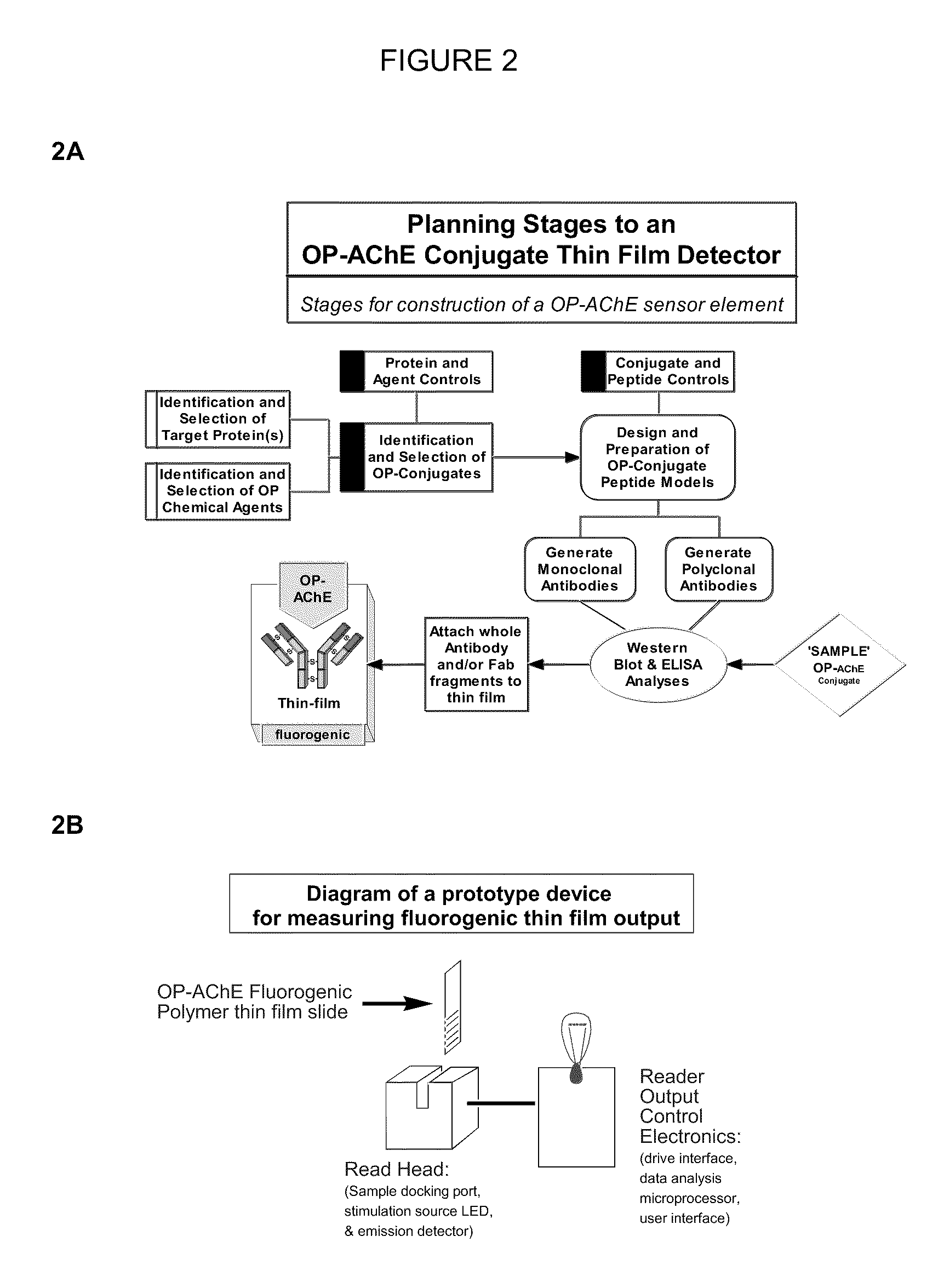Biomarker detection-2
a biomarker and detection technology, applied in the field of biomarker detection, can solve the problems of oxon form and direct toxicity, serious and constant threat to military personnel and civilians, and numerous short- and long-term health hazards of civilian populations, and achieve the effect of efficient and rapid detection methods
- Summary
- Abstract
- Description
- Claims
- Application Information
AI Technical Summary
Benefits of technology
Problems solved by technology
Method used
Image
Examples
example 1
Identification, Synthesis, Purification and Characterization of OP-Modified Peptide Conjugates Representing AChE Inhibited by Sarin
[0268]In the following the section the term “native” refers to an amino acid sequence that is present in biological-derived protein and does not refer to the tertiary structure of a peptide containing the amino acid sequence. To obtain antibodies to sarin-modified AChE, a peptide corresponding in sequence to the active site of an acetylcholinesterase and containing the active site Serine is prepared. Also, peptides containing serine residues modified at the hydroxyl with phosphorus groups, expected from the mechanism by which sarin inhibits AChE, are prepared. The modified peptides correlate in structure to the initially formed OP-AChE conjugate and the subsequently formed aged OP-AChE conjugate. The peptide to be chosen represents a sequence sufficient to generate antibodies to allow for specific identification of the phosphorus group in the context of ...
example 2
Preparation of Hapten-Carrier Protein for Production of Polyclonal Antibodies that are Specific for “Native” AChE, AChE Phosphopeptide and Sarin-AChE Conjugates
[0271]Decapeptides representing the initial VX-inhibited, Sarin-inhibited, and Soman-inhibited AChE OP-conjugates (4-VX, 4-sarin, and 4-soman) are prepared from three distinct methyl phosphoramidate reagents that vary only in the identity of the alkoxy group. Reaction of the decapeptide 3a with each of the methyl phosphoramidates in which the alkoxy group varies from ethoxy (VX), to isopropoxyl (sarin), to isohexyl (soman) followed by oxidation of the resulting product to the oxon affords sarin-inhibited (3-sarin), VX-inhibited (3-VX), and soman-inhibited (3-soman) decapeptide structures, respectively. The methyl phosphoramidate reagents are prepared by sequential reaction of methylphosphinic dichloride (MePCl2) with an appropriate alkoxide and HN(i-Pr)2.
[0272]The initial sarin-inhibited AChE undergoes aging to form a methylp...
example 3
Production of Polyclonal Antibodies which Recognize OP-Conjugates
[0277]A sufficient amount for each hapten-carrier protein prepared according to Example 2 is emulsified in Freud's Complete Adjuvant (FCA) and is used to immunize rabbits. A standard or typical anti-sera production protocol is shown in Table 1.
TABLE 1ImmunizationDayProcedure 0NZW Female Rabbit - Prebleed + Sample - 1Y SC / D14Boost SC28Boost SC381st Production Bleed + Sample 38*Optional ELISA Analysis (1st bleed vs. pre-bleed)42Boost SC522nd Production Bleed + Sample 52*Optional ELISA Analysis (2nd bleed vs. 1st bleed)56Boost SC663rd Production Bleed + Sample 66*Optional ELISA Analysis (3rd bleed vs. 2nd bleed)69Client Options: exsanguinate, terminate, extend protocol
PUM
| Property | Measurement | Unit |
|---|---|---|
| molecular weight | aaaaa | aaaaa |
| molecular weight | aaaaa | aaaaa |
| molecular weight | aaaaa | aaaaa |
Abstract
Description
Claims
Application Information
 Login to View More
Login to View More - R&D
- Intellectual Property
- Life Sciences
- Materials
- Tech Scout
- Unparalleled Data Quality
- Higher Quality Content
- 60% Fewer Hallucinations
Browse by: Latest US Patents, China's latest patents, Technical Efficacy Thesaurus, Application Domain, Technology Topic, Popular Technical Reports.
© 2025 PatSnap. All rights reserved.Legal|Privacy policy|Modern Slavery Act Transparency Statement|Sitemap|About US| Contact US: help@patsnap.com



